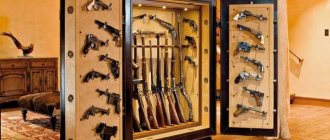The Code of Administrative Offenses and the Criminal Code of the Russian Federation establish liability for illegal possession of weapons. For a person, the difference is colossal. Or administrative punishment. Or a criminal conviction. Therefore, in this publication we will also talk about violation of storage rules, when there is an administrative offense. And about such violations when illegal storage becomes a crime. Rules for storing weapons at home are also posted on the website.
Criminal liability for illegal possession of weapons
Article 222 of the Criminal Code of the Russian Federation establishes liability, inter alia, for illegal possession of weapons. Part 2 and 3 - by a group of persons by prior conspiracy and by an organized group, respectively. But we are talking only and exclusively about firearms. However, the law excludes the following weapons:
- civil firearms smooth-bore long-barreled weapons, their main parts and cartridges for them
- firearms of limited destruction, their main parts and cartridges for them (traumatic weapons)
It turns out that possession of bladed weapons, gas and pneumatic weapons does not constitute a crime.
Firearms can be civilian, service or military. We are also talking about homemade weapons. The main thing is that the charge gains movement due to the energy of the powder or other charge. The main parts of a firearm are: barrel, bolt, drum, frame, receiver.
To understand whether possession of a weapon is a crime, you need to clearly understand what type of weapon we are talking about. For example, the rules for owning a hunting rifle suggest that such weapons can be rifled. If it is rifled, violating storage rules is a crime. But if it’s smoothbore, then no. Since civilian long-barreled smooth-bore weapons are expressly specified in Art. 222 of the Criminal Code of the Russian Federation as an exception.
Responsibility - restriction of freedom (up to 3 years) or forced labor (up to 4 years). Punishment can be arrest for up to 6 months or imprisonment for up to 4 years with a fine (or without it) in the amount of up to 80,000 rubles. (or in the amount of wages or other income of the convicted person for a period of up to three months or.
Minority is applied in such crimes. But it will most likely need to be proven in court. This takes into account the number of weapons (cartridges) that were illegally stored, the motive and purpose, the behavior preceding the commission of the act and (or) during the commission of the act. Voluntary surrender of weapons may be grounds for exemption from criminal liability.
What features distinguish chemical equipment from household appliances?
There are a number of characteristics that make it possible to classify individual products as cold steel weapons. These characteristics include:
- 90 mm – knife blade length; 2.4 mm – blade thickness;
- up to 70 degrees – the angle of convergence of the blade and butt;
- up to 9 mm – blade roll;
- from 25 Rockwell - the hardness of the steel used to make the accessory.
The device must have a finger stop. In addition, the knife must have a sharp tip, which will allow you to stab the object. It is important to add that only certification or the conclusion of an authorized criminologist will allow recognition of a chemical weapons product. There are certain penalties for wearing such products. There is also a measure of liability for the lack of permission to wear such an accessory.
Administrative liability for violation of rules
Article 20.8 of the Code of Administrative Offenses of the Russian Federation establishes responsibility for violation of storage rules for citizens. Part 4 - punishment in the form of an administrative fine from 500 to 2000 rubles. or deprivation of the right to acquire and store, or store and carry weapons. The remaining parts are or are associated with other actions (part 4.1. - carrying a firearm while intoxicated). Or they are aimed at other entities (Part 1 - for legal entities).
Unlike a crime, in this case we are talking about any type of weapon. When you first need to obtain permission to purchase weapons, to store and carry them. In criminal law we are talking specifically about illegal possession. That is, a person does not have the right to keep weapons. In administrative law - about violation of rules. This also includes cases where a person expires his storage permit. Or the keys to the safe will hang in the key holder, to which not only the owner of the storage permit, etc. has access.
There is also part 6 of Art. 20.8. Code of Administrative Offenses of the Russian Federation - illegal acquisition, sale, transfer, storage, transportation or carrying of civilian smooth-bore firearms and limited-kill firearms. Liability from fine to arrest. But necessarily with the confiscation of such weapons.
Detailed information about liability for illegal possession of weapons in relation to your situation can be obtained from the site’s duty lawyer.
Requirements for safes for hunting weapons
There are no special requirements for civilians - weapons must be stored in a locked safe or metal cabinet.
However, this is a minimum minimum. The legislation of the Russian Federation does not limit citizens’ right to independently take additional measures to ensure the safety of their weapons. If personal safety is just a formality for you, then all of the above is already enough. Next, we will look at the requirements for safes for hunting weapons from a safety and common sense point of view. 1) Metal thickness. For legal entities, it is prescribed to store weapons in safes and boxes with a wall thickness of 2 mm, gunpowder and cartridges - 3 mm. There is nothing extraordinary in this requirement, since products made of thinner metal are easily broken with improvised means or even without them - watch the video on how to open a gun cabinet with one kick.
For this reason, it also makes sense for civilians to consider models made of metal with a thickness of 2 mm or more.
2) Cartridge compartment. Most gun safes and cabinets are equipped with a lockable cartridge compartment (trazer). Firstly, separate storage of weapons and ammunition is absolutely logical in terms of safety. Secondly, it is practical and simply convenient. The main thing is that the cartridge compartment in the safe is not just for show, but is spacious enough. So that later you don’t have to rack your brains about where to store some of the cartridges.
3) Castle. The most popular is the key one. Because it is reliable, simplest and inexpensive. We can say that this is a classic. Its only inconvenience is the keys, which you need to keep with you at all times, making sure they don’t disappear/fall into the wrong hands.
Buyers often ask consultants: “Which lock is more reliable - a combination lock or a key lock?” The very formulation of such a question is incorrect, since the level of protection is determined by the class of the lock, and not by its type. The type of lock determines its functionality and ease of use.
If there are children at home, it makes sense to pay attention to a combination electronic lock. Then you won’t have to worry about the keys to the safe falling into the hands of a child. In addition, if necessary, the code combination can be easily changed. The main thing is not to be fooled by cheap Chinese crafts, like these:
Questions related to the safe
As it turned out, the requirements for storing rifled weapons at home require the presence of a metal box, or better yet, a safe. In accordance with generally accepted standards, the latter is a device whose base area does not exceed two square meters, intended for storing documentation, valuables, and storage media. It is important to note that, one way or another, the safe is a burglary-resistant structure.
It is necessary to add that the items characterizing the rules for storing smoothbore weapons at home include, at best, the presence of a fireproof safe. It should be understood as a device whose base area does not exceed two square meters, intended for storing documentation, valuables and storage media, resistant not only to hacking, but also to the destructive factors of fire.
What determines the burglary resistance indicator? This is the number of resistance units that can be obtained by breaking into a container with full or partial access. It is necessary to add that full access, in addition to passing through the hole into the safe, implies opening the safe door to a width exceeding three hundred millimeters, or removing the built-in device.
Carrying a weapon
Today, citizens of the Russian Federation carry weapons on the basis of license permits issued by internal affairs bodies to carry and, accordingly, store certain types, types and sizes of weapons - during sporting events, hunting or shooting for educational or training purposes.
It is important to note that it is strictly prohibited to use cartridges and weapons that are technically faulty, as well as mechanized sprayers, aerosols and other devices that are equipped with irritants and tear substances, the storage period or expiration date of which has expired. The exception here is cases of testing and research work or checking the technical condition of devices.
You need to know that when carrying a weapon, any citizen is required to have a personal document proving his identity. This could be a passport, military or hunting ID, or service ID. In addition, the citizen must have with him a license issued by the internal affairs authorities to carry and, accordingly, store the weapons he has.
What weapons cannot be used in Russia?
The Criminal Code of the Russian Federation stipulates in detail which chemical weapons are prohibited from being carried on the territory of Russia. Such accessories cannot be used not only as civilian weapons, but also as service weapons.
In particular, we are talking about products:
- Blade-type weapons whose blade length exceeds 90 mm.
- Products in which the blade is removed from the handle by automatic ejection after pressing the button. After extension, the blade is securely fixed.
- The blade extends using accelerated movement or gravity, after which it locks automatically.
Possession and use of such weapons may be regarded as non-compliance with the rules and regulations for handling bladed weapons, which means that the owner may be prosecuted.
Third commentary to Article 224 of the Criminal Code of the Russian Federation
1. The objective side of the crime is characterized by the following features: a) action (inaction) expressed in careless storage of firearms, which created conditions for use by another person; b) grave consequences resulting from this; c) a causal relationship between the specified action (inaction) and the resulting harmful consequences.
2. Violation of the rules for storing firearms consists of a person’s failure to comply with specially established and known to him or generally accepted rules for storing them (for example, leaving a firearm in a place accessible to other persons, transferring it to a person who does not have the skills to handle it). In this case, the person must legally own a firearm.
3. A mandatory element of a crime is the creation, as a result of careless storage of a weapon, of conditions for its use by other persons, if this resulted in grave consequences, for example, the death of a person or the infliction of serious harm to health (intentional or careless, due to an accident), the commission of a crime with the help of a weapon .
4. The subjective side of the crime is characterized by careless guilt in the form of frivolity or negligence. In our opinion, negligence in the context of this article reflects the generally careless attitude of the perpetrator towards the occurrence of grave consequences.
5. The subject of the crime is the owner or legal owner of the weapon who has reached the age of 16.
A person who carelessly stored a firearm that was in his possession illegally, if this resulted in grave consequences, is liable under Part 1 of Art. 222 of the Criminal Code. ‹Article 223.1. Illegal production of explosives, illegal production, alteration or repair of explosive devicesUp Article 225. Improper performance of duties for the protection of weapons, ammunition, explosives and explosive devices ›
Storage of weapons by legal entities
It is important to note that the requirements for storing hunting weapons at home (2016 did not introduce amendments to this law) for individuals are somewhat different from the requirements for legal entities. In accordance with the law, weapons products must be stored by legal entities in cabinets, drawers, pyramids and safes, which are installed in specialized premises. In addition, storage, one way or another, is carried out in a discharged state, with a lubricated and clean trigger in the lowered position, which is placed on the safety, separately from the cartridges.
A necessary condition is the attachment of tags indicating the type, number and model of the product in accordance with the inventory and number book and securing weapons structures on weapons located in safes, cabinets, pyramids or boxes. This rule applies to all legal entities.
If a legal entity has special statutory tasks, in its weapons room, in accordance with the law, it is allowed to store cartridges in magazines, stocks, removable drums or clips. It is necessary to add that the product in its original packaging (box, box) can be stored on racks. Cartridges in bulk are stored exclusively in metal boxes, which are closed with two different secret locks. In addition, the following items are stored separately in separate cabinets, pyramids, safes or drawers:
- Weapons and ammunition (with the exception of the cases specified in paragraph 164 of the above-mentioned law). It is important to note that cartridges that contain pyrotechnic compositions or are filled with irritating and tear-producing substances, as well as cartridges that have misfired, are stored in separate packaging.
- Artistically designed weapons of all varieties that contain precious stones or metals.
- Weapons seized or accepted, in accordance with temporary storage, from citizens or employees of other legal entities.
- Gunpowder packaged in specialized sealed metal boxes (closures), as well as gunpowder packaged in plastic bags for retail trade.
The final main provisions of the legislation, which in one way or another relate to the storage of weapons by legal entities, is that metal boxes and cabinets in any case must be locked, and also have a thickness exceeding two millimeters (in the case of storing gunpowder, cartridges and for products containing a pyrotechnic charge, this indicator must be equal to or exceed three millimeters).
What bladed weapons are ordinary citizens allowed to carry?
The classification of such accessories is very broad and contains descriptions of different models and types. Citizens can own and carry certain types of products. Of course, for this you will first need to obtain a special license. The permitted types of weapons include the following:
- Hunting bladed weapon. People who have permission to use hunting firearms have the opportunity to carry such weapons. After purchasing such an item, the seller is obliged to make an appropriate inscription in the buyer’s hunting license. The official document for the item will be a firearms permit.
- Traditional bladed weapons - checkers, sabers, daggers. Such weapons are allowed to be purchased together with national costumes of different nationalities of the Russian Federation, including Cossack uniforms. There is a list approved by the Russian Government, which provides complete information about national costumes.
Other circumstances, when a person was found with an object that qualifies as a bladed weapon, may be considered an offense. The owner of the product will be held liable as prescribed by current legislation.
Transporting weapons
It is important to keep in mind that owners of cartridges and weapons for their transportation throughout the Russian Federation must obtain appropriate permission from the licensing department at their place of residence and registration.
Citizens who organize the transportation of more than five weapons and more than four hundred cartridges belonging to them are obliged to provide the state internal affairs bodies, in accordance with the place where the weapons are registered, with an application, as well as information about the weapons and cartridges, the route of movement and the transport used , as well as regarding persons who are planned to be involved in the implementation of security measures, in order to obtain the necessary permission. It is important to add that the validity period of the transportation license is established based on the calculation of the actual time required to deliver cartridges and weapons directly to their destination. However, the period should not exceed one calendar month.
These are the basic requirements for storing and transporting weapons on the territory of the Russian Federation. Failure to comply with them is fraught with problems with the law, the imposition of sanctions on the person who violated the law and endangered other people.







